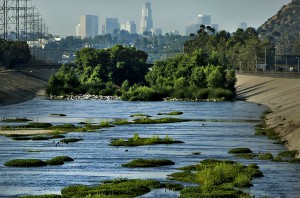For the first time in decades, people in Los Angeles this month were able to paddle along the much-maligned and concrete-encased Los Angeles River without breaking the law. It was, if you’ll pardon the pun, a watershed moment — both for the river, which is making a comeback in the eyes of the general public as well as elected officials; and for the greater Los Angeles community, which is slowly coming to grips with the fact that it has a potentially dynamic natural resource threading its way through neighborhoods that are starved for high quality green space.

Even the U.S. Corps of Engineers, the same outfit that tamed the flood-prone river in the 1930s by building levees and a concrete channel for the formerly wild LA river, is coming on board. This past month’s float down the Sepulveda Basin section of the river included civic officials as well as Mark Toy, District Commander of the Corps of Engineers. As reported by the LA Times on 9 August 2011,
Los Angeles is urban territory, and this 1.5-mile trip is arrow-straight, flanked by the San Diego and Ventura freeways and strewn with discarded bicycles, shopping carts, trash and, occasionally, the carcasses of rodents.
It is also home for 212 species of birds, including yellow warblers, hooded orioles and the federally endangered least Bell’s vireo.
In July, U.S. Army Corps of Engineers District Commander Col. Mark Toy issued the license allowing the Los Angeles Conservation Corps to operate the program along a soft-bottom stretch of the river between Balboa and Burbank boulevards, about 17 miles northwest of downtown Los Angeles.
On Monday, his participation in the program’s inaugural “ceremonial paddle” was viewed by environmentalists as an important juncture in the history of the river that was tamed and polluted in the 1930s by the corps’ concrete walls and 12,000 storm drains.
“For more than a century, the U.S. Army Corps of Engineers has built walls between people and their rivers here in Los Angeles and nationwide,” said David Beckman of the Natural Resources Defense Council. “So to have the corps’ district commander metaphorically jumping over that wall and into a boat is symbolic and potentially very important.”
Toy shrugged off such accolades, saying, “This is a team effort, and I’m proud to be a part of it. What we learn from the program this year will help shape the future of the river.”
The recent resurgence of interest in the LA River, spurred by river enthusiasts and environmental advocates, exemplifies an important axiom in relation to urban streams. If people start using them for recreation, they suddenly become more important, no matter their state of abuse or degradation. And such usage, in turn, spurs efforts to clean up the rivers in order to benefit from their important functions as green corridors.
This has long been the case with the Chicago River, which has experienced a remarkable resurgence in recent decades since the formation of the non-profit river advocacy group Friends of the Chicago River in the 1970s. Now canoe races are held along various stretches of the river, schoolchildren and adults come to the water to learn about aquatic ecology and urban conservation, and the city has poured millions of dollars into building attractive riverwalks and improving water quality — all testament to the fact that the river is a cultural amenity and economic resource.
Yet even Chicago has a long, long way to go before its channelized, reversed, and polluted waterways regain their ecological health and biodiversity. The mere name of the transformed south branch of the river — the Sanitary and Ship Canal — indicates its primary identity as a transportation conduit and sewage conveyance channel, rather than as a living river. But the Metropolitan Water Reclamation District’s recent decision to plan for disinfecting the treated wastewater it releases into the Chicago Area Waterway System (CAWS) is a landmark step in working toward the river’s ecological improvement and reshaping that identity which dates from the late 19th century.
It looks like LA, with the Corps of Engineers’ recent foray on the river and the building public interest in exploring its hidden reaches, is taking initial steps down a similar path. The ultimate goal: to treat urban rivers like living ecosystems, which they are, instead of mere tools for flood control, shipping, and wastewater management.
3 thoughts on “Seeing Rivers as Ecosystems in LA and Chicago”
Comments are closed.